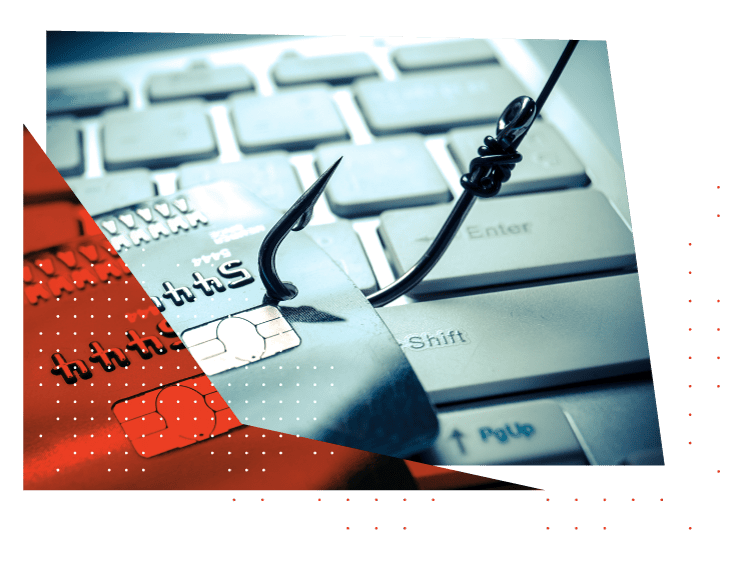05 Dec Don’t Get Hooked: Combatting Cyber Threats with Phishing Awareness Training
From online scams to fraudulent emails, phishing is a type of cybercrime that poses a growing threat to companies. Undoubtedly, it’s one of the most significant social attacks today. Still, as long as organizations remain vigilant and tech-savvy, they can address this issue quickly and effectively. There will always be criminals on the digital front trying their luck to breach data systems. However, what takes the cake is their eagerness to hoodwink unsuspecting personnel into giving out confidential details like passwords and credit card numbers. Currently, it’s the most rampant form of social engineering, so employers must double down on their security measures to ensure they sink the phish successfully!
The FBI Internet Crime Complaint Center received 241,342 phishing-related complaints in 2020.


In a world where malicious actors are always looking for creative and inventive ways to exploit weaknesses in digital security systems, businesses need to stay one step ahead. They need to prepare for the threat of cyberattacks. As cybercrimes become more sophisticated and targeted, it becomes increasingly important to ensure that employees and users of digital systems are aware of potential risks and have the training to protect the organization from falling victim to online scams. A vital element of this training is phishing awareness, which can help organizations identify and address potential threats before they become a severe problem. In this blog post, we’ll discuss the importance of phishing awareness training and how it can help organizations combat cyber threats. We’ll also provide tips on creating a successful training program and ensuring that your employees and users stay vigilant against phishing attacks.
Training your staff to spot phishing emails is a great way to protect your business. You could use a managed service provider like ACIS® to do the work for your business. Or you have a staff of individuals by creating security teams that look for phishing emails on their own. Your company can benefit from having someone who knows what to look for and can quickly recognize an email that could be a scam.





What is Phishing?
Cybercriminals use phishing to trick users into disclosing personal information or providing access to a computer or network system. These fraudulent messages include links to spoofed websites or malicious attachments.
This cybercrime typically targets bank customers or those using online payment services. Attackers can gain access to a victim’s accounts by using sign-on information. They can also steal bank accounts and sell personal information to others.
Cybercriminals craft the typical phishing email to look like an email from a legitimate institution, such as a bank or government office. The message may say something is wrong with the victim’s account and demand immediate action. It may also include an attachment that downloads malware onto the victim’s computer. The malware may be ransomware or an infection of the virus known as a key logger.
Often cybercriminals disguise these malicious attachments with unsuspicious file names. Small programs embedded in the malicious attachments can search for anything on the victim’s computer. These programs can then be run secretly in the background and on a user’s device and find information. The information found can be used to initiate or escalate an attack. These attachments can also send data to a different location.
The most common form of phishing is deceptive phishing. Typically deceptive phishing involves sending an email that looks like it’s from a legitimate organization or business but contains malicious content. The email may ask the recipient to log in to their account and provide personal information, such as bank account numbers or account usernames and passwords.
What is Phishing?
Cybercriminals use phishing to trick users into disclosing personal information or providing access to a computer or network system. These fraudulent messages include links to spoofed websites or malicious attachments.
This cybercrime typically targets bank customers or those using online payment services. Attackers can gain access to a victim’s accounts by using sign-on information. They can also steal bank accounts and sell personal information to others.
Cybercriminals craft the typical phishing email to look like an email from a legitimate institution, such as a bank or government office. The message may say something is wrong with the victim’s account and demand immediate action. It may also include an attachment that downloads malware onto the victim’s computer. The malware may be ransomware or an infection of the virus known as a key logger.
Often cybercriminals disguise these malicious attachments with unsuspicious file names. Small programs embedded in the malicious attachments can search for anything on the victim’s computer. These programs can then be run secretly in the background and on a user’s device and find information. The information found can be used to initiate or escalate an attack. These attachments can also send data to a different location.
The most common form of phishing is deceptive phishing. Typically deceptive phishing involves sending an email that looks like it’s from a legitimate organization or business but contains malicious content. The email may ask the recipient to log in to their account and provide personal information, such as bank account numbers or account usernames and passwords.





A Few Types of Phishing Attacks
Two other phishing tactics are spear phishing and whaling. Spear phishing is “the fraudulent practice of sending emails ostensibly from a known or trusted sender to induce targeted individuals to reveal confidential information.” According to cyber security software company Trend Micro, “Spear phishing targets a specific group or type of individual such as a company’s system administrator.”
Whale attacks, on the other hand, target larger fish, i.e., whales. Trend Micro says, “These attacks typically target a CEO, CFO, or any CXX within an industry or a specific business. A whaling email might state that the company is facing legal consequences and that you need to click on the link to get more information. The link takes you to a page where you are asked to enter critical data about the company such as tax ID and bank account numbers.”







How Does Phishing Work?
An attacker poses as a trustworthy person or organization during a phishing attack. They then convince the victim to reveal personal and sensitive information. They can use this information to gain access to financial accounts. The attacker may also use the information to extort a ransom.
The most common forms of phishing attacks are email and text messages. But cybercriminals can also launch a phishing campaign via live phone calls and instant messaging.
Phishing emails often contain a link or fake sign-in page. If the user clicks on the phishing link, their computer will infect with malware. They can also download malicious attachments and send data to another location. Some of these attachments may be malicious Microsoft Office documents or faxed documents.
The goal of a phishing attack is to obtain personal information, such as bank account numbers, passwords, credit card information, and other valuable information. Phishers have become sophisticated in recent years and have adapted their tactics to include more attack vectors.
Successful phishing attacks make their victims feel pressured and anxious about their security. Using urgency and a fake website, they lure their victims onward. This sense of anxiety and urgency makes the victim more likely to click on the link.
The attacker can also create a fake email account, which looks legitimate, but they control the account to send a phishing email. Then, they will prompt the victim to log into a fake website that looks like a legitimate organization’s website. The phony website asks for the victim’s sensitive information. The attacker can then download malware onto the victim’s computer and potentially gain access to the victim’s company network.
How Does Phishing Work?
An attacker poses as a trustworthy person or organization during a phishing attack. They then convince the victim to reveal personal and sensitive information. They can use this information to gain access to financial accounts. The attacker may also use the information to extort a ransom.
The most common forms of phishing attacks are email and text messages. But cybercriminals can also launch a phishing campaign via live phone calls and instant messaging.
Phishing emails often contain a link or fake sign-in page. If the user clicks on the phishing link, their computer will infect with malware. They can also download malicious attachments and send data to another location. Some of these attachments may be malicious Microsoft Office documents or faxed documents.
The goal of a phishing attack is to obtain personal information, such as bank account numbers, passwords, credit card information, and other valuable information. Phishers have become sophisticated in recent years and have adapted their tactics to include more attack vectors.
Successful phishing attacks make their victims feel pressured and anxious about their security. Using urgency and a fake website, they lure their victims onward. This sense of anxiety and urgency makes the victim more likely to click on the link.
The attacker can also create a fake email account, which looks legitimate, but they control the account to send a phishing email. Then, they will prompt the victim to log into a fake website that looks like a legitimate organization’s website. The phony website asks for the victim’s sensitive information. The attacker can then download malware onto the victim’s computer and potentially gain access to the victim’s company network.





Benefits of Phishing Awareness Training
Increasing awareness of phishing techniques is a great way to boost security in your business. It helps your employees become more vigilant in spotting suspicious emails and taking the correct measures to protect your business.
Phishing is a form of social engineering where hackers prey on vulnerabilities in people. The attack includes malicious attachments, links, and web pages. Cybercriminals often send these phishing attacks in bulk to large groups of people. In addition to these attacks, attackers also use other tactics, such as social engineering, to gather information.
If you are looking for an effective way to teach your employees about phishing, you can implement a phishing training program that uses simulated phishing. Using a phishing simulation will help promote safe email practices while also measuring the impact of your training.


A phishing simulation will provide your employees with a realistic experience that teaches them how to spot a phishing attack. It is also a great way to show department managers and C-level executives the value of cybersecurity.
A good phishing simulation program should be automated and run regularly. It should also adapt to the specific needs of your organization. For instance, it could modify templates to reflect topical scams.
A phishing awareness training program should keep users at the highest security awareness levels. The phishing training should simulate phishing emails twice a year. The emails from phishing tests should mimic phishing emails from well-known brands and redirect users to a secure web page.



Security Awareness Training Strategies for Maximum Effectiveness
Identifying the best security awareness program training for maximum effectiveness in spotting real-world attacks through phishing emails is crucial in preventing a data breach. The consequences of an attack can be devastating. For example, users could be at risk of account lockout, ransomware attacks, or business email compromise scams.
In addition to identifying the best phishing training solutions for maximum effectiveness in spotting these emails, it is crucial to conduct regular phishing tests on employees simulating real-world attacks and other social engineering attacks. These tests can help identify employees who fail to recognize threats and give them additional phishing awareness training to help them actively spot threats in their emails. The phishing tests can also help companies align their strategy with larger business goals.
Phishing email training teaches employees how to recognize phishing signs and attachments. The phishing email training can be done on the fly or as part of a broader security program. Tailor the exercise to different groups of employees and make it an interactive gamified experience.
Companies should also implement recurring simulated phishing campaigns. This simulated attack allows employees to learn about the security risks associated with phishing. The company can integrate the simulated attack into its security protocols. Mock phishing tests are also an effective way to build resilience in the workforce.
Another essential training strategy for maximum effectiveness in spotting phishing emails involves utilizing personalized content. People are more likely to remember personalized content and can apply it during an actual phishing attack.
Providing employees with real-world experiences will encourage them to pay attention to security. It is vital that a phishing simulation campaign is interactive, gamified, and targeted to the employees in question. Providing immediate feedback and additional training after phishing tests is also essential.
Security Awareness Training Strategies for Maximum Effectiveness
Identifying the best security awareness program training for maximum effectiveness in spotting real-world attacks through phishing emails is crucial in preventing a data breach. The consequences of an attack can be devastating. For example, users could be at risk of account lockout, ransomware attacks, or business email compromise scams.
In addition to identifying the best phishing training solutions for maximum effectiveness in spotting these emails, it is crucial to conduct regular phishing tests on employees simulating real-world attacks and other social engineering attacks. These tests can help identify employees who fail to recognize threats and give them additional phishing awareness training to help them actively spot threats in their emails. The phishing tests can also help companies align their strategy with larger business goals.
Phishing email training teaches employees how to recognize phishing signs and attachments. The phishing email training can be done on the fly or as part of a broader security program. Tailor the exercise to different groups of employees and make it an interactive gamified experience.
Companies should also implement recurring simulated phishing campaigns. This simulated attack allows employees to learn about the security risks associated with phishing. The company can integrate the simulated attack into its security protocols. Mock phishing tests are also an effective way to build resilience in the workforce.
Another essential training strategy for maximum effectiveness in spotting phishing emails involves utilizing personalized content. People are more likely to remember personalized content and can apply it during an actual phishing attack.
Providing employees with real-world experiences will encourage them to pay attention to security. It is vital that a phishing simulation campaign is interactive, gamified, and targeted to the employees in question. Providing immediate feedback and additional training after phishing tests is also essential.



Understanding the Risks of Inadequate Phishing Awareness Training
Malicious actors are always on the lookout for vulnerable targets, so making sure everyone in your organization is trained to spot phishing attempts is critical. Otherwise, you might expose your company and employees to dangerous data breaches! It can also lead to losing trust with customers and partners and reputational damage. It is essential to understand the types of phishing attacks and how they work so that staff can identify and avoid them. Additionally, organizations should ensure that their employees understand the importance of not responding to requests for sensitive information or clicking on suspicious links in emails. Organizations can reduce the risk of a phishing attack and protect their data by having a comprehensive security awareness program.





Call ACIS® Today for Security Awareness Training Programs
Cybercrime is a constant and growing threat to organizations of all sizes. By increasing phishing awareness among employees and users, organizations can help combat these threats. A phishing awareness program can equip employees with the knowledge and tools to identify potentially malicious emails and websites, protecting the organization and its data from harm. ACIS® IT Solutions provides invaluable phishing awareness training that equips employees with the tools they need to stay safe. This includes recognizing advanced attempts, following a proactive approach if fraud occurs, and properly reporting suspicious activity. Be secure in your online world with ACIS®! To learn more about our services or schedule phishing awareness training for your organization, call us at (417) 823-7100.
Call ACIS® Today for Security Awareness Training Programs
Cybercrime is a constant and growing threat to organizations of all sizes. By increasing phishing awareness among employees and users, organizations can help combat these threats. A phishing awareness program can equip employees with the knowledge and tools to identify potentially malicious emails and websites, protecting the organization and its data from harm. ACIS® IT Solutions provides invaluable phishing awareness training that equips employees with the tools they need to stay safe. This includes recognizing advanced attempts, following a proactive approach if fraud occurs, and properly reporting suspicious activity. Be secure in your online world with ACIS®! To learn more about our services or schedule phishing awareness training for your organization, call us at (417) 823-7100.






